
Potentilla erecta is a herbaceous perennial plant belonging to the rose family (Rosaceae).

The Chilean recluse spider, Loxosceles laeta, is a highly venomous spider of the family Sicariidae. In Spanish, it is known as araña de rincón, or "corner spider"; in Brazilian Portuguese, as aranha-marrom or "brown spider". It is considered by many to be the most dangerous of recluse spiders, and its bites often result in serious systemic reactions, up to and including death.

Anthomyzidae is small, slender, yellow to black flies with narrow and elongated wings, which may have distinct markings. Some species have greatly reduced wings. Fewer than 100 species are known, mostly from Europe. Although they occur in all major regions, they seem to be most varied in the Holarctic region.
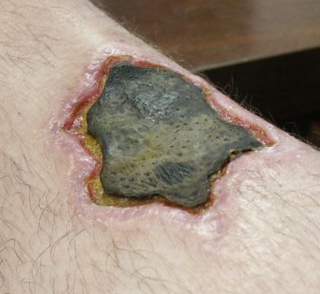
Loxoscelism is a condition occasionally produced by the bite of the recluse spiders. The area becomes dusky and a shallow open sore forms as the skin around the bite dies (necrosis). It is the only proven type of necrotic arachnidism in humans. While there is no known therapy effective for loxoscelism, there has been research on antibiotics, surgical timing, hyperbaric oxygen, potential antivenoms and vaccines. Because of the number of diseases that may mimic loxoscelism, it is frequently misdiagnosed by physicians.

Senegalia laeta, the gay acacia or daga, is a legume found in the family Fabaceae. It was formerly included in the genus Acacia.

Willis's antbird, also known as the laeta antbird, is a species of bird in the family Thamnophilidae. It is endemic to Brazil. It was formerly considered a subspecies of dusky antbird.
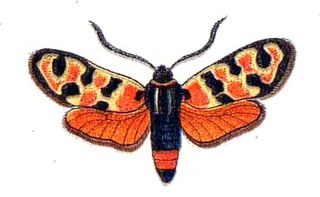
Zygaena fausta is a member of the family Zygaenidae, the day-flying burnet moths. Its bright aposematic colours of red, white and black on the wings indicate to possible predators such as birds that it is foul tasting or poisonous. In flight, the bright red abdomen is revealed, contrasting with the white legs and black head and antennae; the thorax is black and white with an eye spot on each side. There appears to be a considerable variation in pattern among specimens from different parts of Europe.
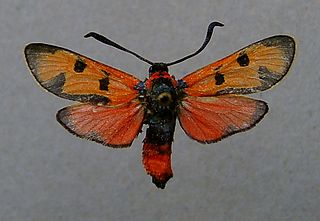
Zygaena laeta, the bloodword burnet, is a moth of the family Zygaenidae. It is found in Central and South-Eastern Europe.In Z. laeta the collar and patagia as well as the apical half of the abdomen are red: also the wings are testaceous red except some black spots on the forewing. Larva of light bluish green, with while dorsal and lateral lines, along which there are blackdots. Pupa yellow, anteriorly dark brown, in a whitish cocoon. The wingspan is 26–34 mm.

Globia laeta, the red sedge borer, is a moth of the family Noctuidae. The species was first described by Herbert Knowles Morrison in 1875. It is found in North America, including Ohio, Illinois, New Jersey and Ontario.
Pyrrhulina laeta, known as the half-banded pyrrhulina or half-lined pyrrhulina, is a fish found near Pebas, Peru, and in tributaries of the Ampiyacu River. It is frequently confused with other species.

Russula laeta is a brittle gill species that was first described by Julius Schäffer in 1952. This species is critically endangered in Belgium.
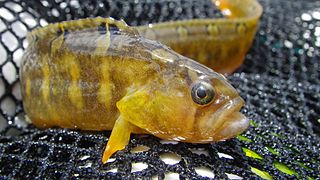
The crescent gunnel, also known as the bracketed blenny, is a species of marine ray-finned fish belonging to the family Pholidae, the gunnels. This fish occurs in the shallow coastal waters of the eastern North Pacific Ocean.
Quercus laeta is an oak species in the white oak section, Quercus section Quercus, in the beech family. It is widespread across much of Mexico from Sinaloa and Nuevo León south as far as Oaxaca.

Naticopsis is an extinct genus of small sea snails belonging to the family Neritopsidae.

Cratosilis denticollis is a species of soldier beetle belonging to the family Cantharidae.

Caribena is a genus of spiders in the family Theraphosidae (tarantulas), found in the Antilles. The two species accepted as of March 2017 were formerly placed in Avicularia. Apart from a different distribution – Avicularia species are found in mainland South and Central America – Caribena is distinguished by having longer and thinner type II urticating hairs in a conspicuous patch on the upper surface of the abdomen. Males also have a differently shaped palpal bulb.

Caribena laeta otherwise known as the Puerto Rican Pink Toe Tarantula is a species of spider in the family Theraphosidae, found in the US Virgin Islands, Puerto Rico, and Cuba, the last dubiously according to Caroline Fukushima and Rogério Bertani in 2017. It was first described by Carl Ludwig Koch in 1842 under the name Mygale laeta.
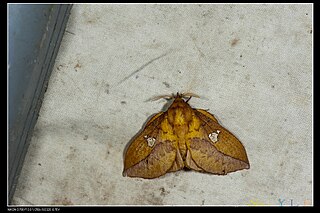
Euthrix laeta is a moth of the family Lasiocampidae first described by Francis Walker in 1855.

Myosotis laeta is a species of flowering plant in the family Boraginaceae, endemic to ultramafic areas of the Sounds-Nelson area of the South Island of New Zealand. Thomas Cheeseman described the species in 1885. Plants of this species of forget-me-not are perennial rosettes which form loose tufts or clumps, with ebracteate, erect inflorescences, and white corollas.

















